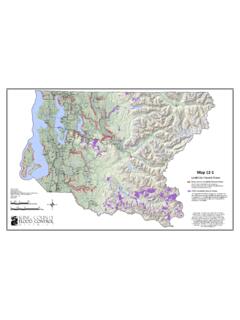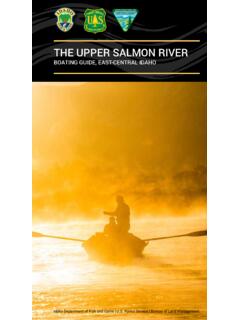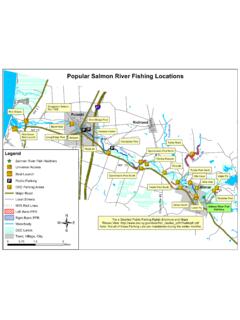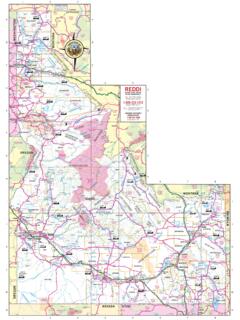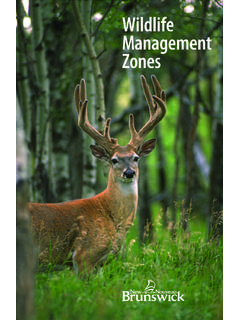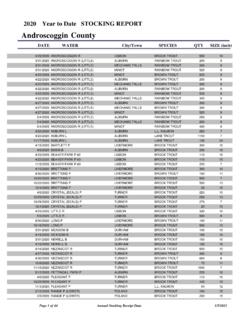Transcription of Bulkheads and Shoreline Stabilization
1 Gullies formwhere vegetation is clearedArti cial ll and bulkhead eliminate natural beach contourWave action may cause increased scouring of the beach, destabilizingthe bulkhead and resulting in loss of sand and gravel habitatsBulkheads and Shoreline StabilizationShoreline StabilizationKing County s existing Shoreline regulations limit construction of new Shoreline Stabilization structures, including Bulkheads , levees and revetments (levees are very similar in nature to revetments). Shoreline bank Stabilization is allowed for the purpose of protecting existing, legally established structures and public improvements, as well as preservation of important agricultural lands from loss or damage due to bank erosion. King County requires an applicant for a Shoreline bank stabili-zation project to first consider first the non-structural alterna-tives and to demonstrate to the county that such alternatives are not feasible.
2 Location and height limits are also identified in the regulations. King County rules also require the applicant to demonstrate that wave action or fluvial force is the primary agent of erosion. Other causes, such as poor drainage or improper vegetation management, must be corrected prior to approval for a Shoreline Stabilization structure. King County s proposed changes would maintain the currently existing policies on Shoreline Stabilization , but would incorpo-rate additional measures to protect habitat. New bank stabiliza-tion projects would be required to comply with the Washington State Integrated Streambank Protection Guidelines (WDFW 2003). Biotechnical slope Stabilization measures would be required for new revetments, armoring, or other measures for stabilizing river banks. Other causes, such as poor drainage or improper vegetation management, must be corrected prior to approval for a Shoreline Stabilization structure.
3 A geotechnical study would be required to evaluate the processes acting both at and near the site of proposed bank Stabilization . Project pro-posals for new Shoreline Stabilization on the marine shorelines of Vashon Island would be analyzed to avoid placement of new bank armor either on or adjacent to feeder bluffs, salmonid and forage fish habitat, or eelgrass Stabilization projects that protect existing single family residences often qualify for exemption from the requirement for obtaining a Shoreline Substantial Development Permit (SSDP). However, proposals to construct new bank stabiliza-tion projects would be reviewed as part of a building permit or a clearing and grading permit application, in addition to other federal permits and approvals that may be needed. In Forestry, Resource, and Natural Environments, construction of a new Shoreline Stabilization project would require a Shoreline Condi-tional Use Permit. Requests to repair existing bank Stabilization structures ( Bulkheads , revetments and levees) would continue to require a separate application for Shoreline Substantial Development Permit exemption (SSDPE), which would result in an official letter recognizing the exemption.
4 The Effects of Bulkheads on Beach ShorelinesWhat are Bulkheads ? Bulkheads are man-made structures constructed along marine and lake shorelines to reduce Shoreline erosion. Construction materials commonly used include wood pilings, large boulders stacked to form walls, or hard surfaced walls built of concrete or other similar material. B U L K H E A D S(Continued on reverse side)How Bulkheads Change BeachesOften considered a form of Shoreline protection, studies over the past few decades have shown that Bulkheads can actu-ally increase erosion of the beach in front of the bulkhead, as well as starve downdrift beaches of incoming sediment. These changes in sediment inputs can negatively impact the fish and wildlife habitat associated with the tidal zones or offshore shal-low areas, as well as nearby terrestrial habitats such as cliffs, snags, mature trees, dunes, and meadows. Specific effects include: Increased beach erosion.
5 Waves reflect or bounce off the hard bulkhead surface, scouring away beach sediments. As a result, marine Shoreline armoring can, over time, increase rather than decrease nearby erosion. Loss of sand. Increased scouring action can transform a sandy beach into one composed of gravel, cobbles, bedrock or hard clay. Changes in sediment will affect the plants and animals that can live there. Scouring can also lead to the loss of sand and gravel covering bulkhead footings, thereby causing these structures to become more vulnerable to failure. Loss of sediment. Bulkheads can close off the supply of sand and gravel from upper banks that replenishes fine sediment to the beach areas. Certain fish, such as surf smelt and sand lance prefer spawning on beaches with fine sedi-ment. Their habitat is degraded if the sediment is eroded and not replaced. Loss of Shoreline vegetation. Bulkhead construction often entails direct removal of plants that stabilize bank soils and contribute organic matter to Shoreline areas, thereby negatively impacting habitat for marine fish and wildlife.
6 Bulkheading may also permanently prevent regrowth of na-tive Shoreline vegetation. Loss of shade. Vegetation shades the ground and water beneath, creating the necessary cool, dark refuges that cer-tain fish and other wildlife need to survive and reproduce. Vegetation lost through bulkheading reduces these critical areas. Loss of habitat for marine species. Please see the chart that smeltPacific sand lanceRock soleJuvenile salmonPacific herringHardshell clamsGeoduckOystersDungeness crabSea cucumberSea urchinsBULKHEADING EFFECTSA rmoring-related habitat shiftLoss of spawning habitatLoss of Shoreline vegetationLoss of wetland vegetationLoss of large organic debrisChanges in food resourcesLoss of migratory corridorsKeyWell documented evidence of negative potential for negative effects, but not potential for long term effects but not : Shoreline Armoring Effects on Coastal Ecology and Biological Resources in Puget Sound, Washington, Coastal Erosion Management Studies, Volume 7, Washington State Department of Ecology, August, Effects of Revetments on river are revetments?
7 Revetments are very similar to Bulkheads , but typically con-structed along the banks of rivers and streams to prevent erosion and horizontal movement of stream channels. Con-struction materials commonly used include wood pilings, large boulders stacked to form walls, and smaller rock (rip-rap and rubble). Recently, large woody debris has become a popular material for river bank Stabilization . How revetments change the generally considered as protection for human infra-structure (houses, roads, etc), they can also have a variety of negative impacts on people, fish, and wildlife. Specific effects include: Increased erosion. Unless the entire bank is armored, rivers tend to find the path of least resistance, and will erode the areas at either end of a revetment, potentially undermining the entire structure and causing slope failures. Further, revetments can have unintended consequences B U L K H E A D S(Continued on next page)Structureset backNative plantsNatural beach contourRoots forsoil stabilityWoody debrisSand, gravelnearby, such as causing erosion to accelerate on the op-posite bank of the river or downstream from the protected site.
8 Increased rate of transport. Revetments usually simplify the Shoreline edge. This can accelerate water and sediment transport downstream, which may cause salmon nests to be scoured out by the higher flows or buried by increased sediment loads. Fish and wildlife habitat. As noted earlier, revetments are intended to limit erosion or lateral migration of river channels. Migrating rivers, by moving the main channels across the floodplain, create diverse habitats (wetlands, oxbow lakes, new side channels, etc) that serve many dif-ferent fish and wildlife species. Such areas are no longer produced when revetments maintain constant channels. Revetments also alter or reduce habitats along the edges of rivers and streams that are extremely important areas for juvenile salmon . Riparian vegetation. Generally, Shoreline or riparian vegetation is removed for revetment construction, and afterwards the area is kept free of woody vegetation for structural purposes.
9 However, riparian vegetation is very important for good water quality, as well as for fish and wildlife species. It shades rivers and streams, keeping water cold enough to maintain salmon . Branches and leaves hanging low over the water provide places for fish and wildlife to hide from predators. Trees also provide fish food when tree-dwelling insects fall into the water. When leaves fall into the river , they provide aquatic insects with food, which has a positive effect through the food Alternatives to Shoreline Armoring Our improved understanding of Shoreline processes suggests more effective long-term approaches for stabilizing the shore. Natural shorelines are a great model to look for ways to en-hance nature s ability to absorb energy and stabilize the back structures from the shore in combination with preservation or revegetation of a native planting strip buffer is an important part of this plan. Slopes are naturally vulnerable to erosion simply through a natural beach contour free of hard structures for great-est benefit.
10 Let a beach be a will be better for your property, the wildlife it supports and your neighbors properties as well!Retaining and planting native plants along the shore-line has many advantages: The roots bind soils and help buttress and stabilize slopes. Branches and leaves shade underlying areas, thereby help-ing maintain temperature regimes that certain wildlife need to survive and reproduce. The leaves and bark provide habitat for terrestrial insects that are important food sources for aquatic organisms, in-cluding salmon that forage along our freshwater and marine shorelines throughout the U L K H E A D S(Continued on next page) The leaves deflect raindrop energy and help reduce the erosive effects of surface runoff on slopes. They provide escape cover in which fish and wildlife can evade predators, as well as perching and roosting sites for terrestrial wildlife to rest and search for food. Native plants are naturally drought resistant, requiring less water to thrive.



